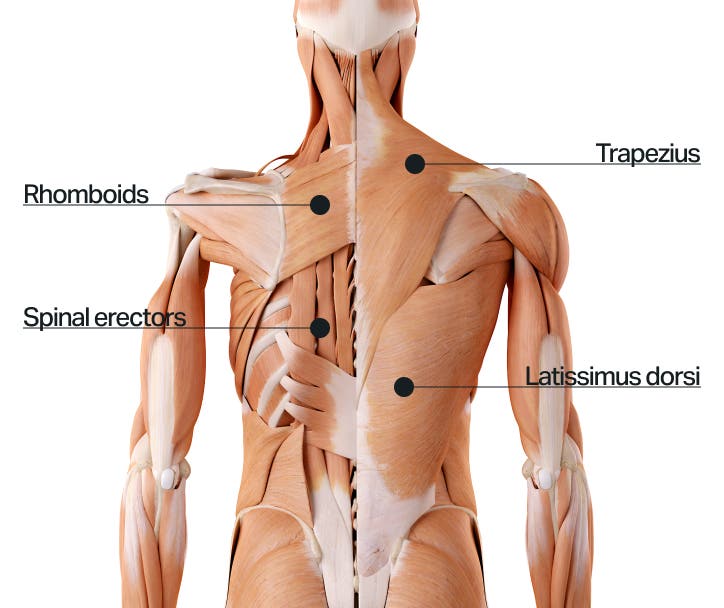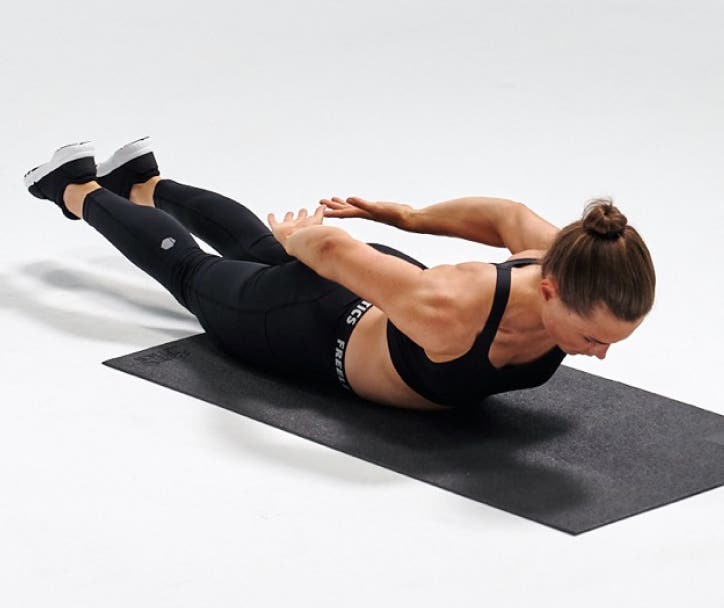The back plays a pivotal role in your daily movement – it quite literally carries you through life. Yet this powerful group of muscles is often overlooked when it comes to training.
A weak back can lead to a multitude of health issues, which is why training these muscles regularly is so essential. In this article we’ll break down the back muscles and which exercises are the most effective for strengthening them.
Trust us, when you incorporate back exercises on a regular basis, you’ll notice a world of difference not only in your performance but also in your posture, stability, and life.
Let’s dive right in with the back’s major muscle groups.
What are the main muscles of the back?
The back is a complex area with many muscles, ligaments, and tendons that are responsible for a variety of movements and functions. Below is an overview of the major muscles of the back:

Trapezius
A large, triangular muscle that runs from the back of the neck to the shoulders and down to the middle of the back. It plays a crucial role in various movements of the shoulder blades and neck, including shrugging, pulling the shoulder blades together, and tilting and rotating the head and neck.
Because of its extensive coverage and involvement in various movements, it's common for people to experience tension or stiffness in the trapezius muscle, especially during periods of stress.
Rhomboids
Another key back muscle group, the rhomboids, runs between your shoulder blades and thoracic spine. Also known as the “posture muscles,” the rhomboids contract and rotate your shoulder blades and help maintain an upright posture.
Latissimus dorsi
A broad muscle on the back of the torso that extends up and across from the sides of the lower and mid-back to the top of the arm. This muscle is commonly referred to as “lats” for short. The lats are primarily responsible for pulling your arms down and in.
Spinal erectors
Going down the length of your back on either side of your spine, is another key muscle group connecting it all together: the spinal erectors. These muscles are small, yet mighty – they’re crucial for both stability and movement.
How do the back muscles function?
Your back muscles have two main functions: Stabilizing and moving your spine (and shoulder blades). Their exact function depends on several factors, such as your body position and the main joint that generates force.
As a rule of thumb, most of your back muscles act as stabilizers – meaning they resist motion when force is applied. For example, when you complete a Squat, your hips and legs move, while your back and upper body remain stable.
On the other hand, during a Back Extension, your spinal erectors extend your spine upwards, moving your back as you complete the exercise.
Movement or not – both functions are vital in everyday life and should be trained regularly.

Why should you train your back muscles?
There are three main reasons for training the back: Health, performance, and looking great.
While back muscles may not get as much hype, a weak back can cause a number of problems in everyday life. If you’ve ever experienced tight shoulders, stiff neck, or even worse – back pain, then you know all too well how debilitating it can be. The best form of medicine here is preventative, prioritizing back-strengthening exercises to ward off any pain.
A strong back is crucial to athletic performance. It aids in coordination, balance, and power via the two functions mentioned above: stability and movement. Your back muscles also play a key role in injury prevention, which is all the more reason to add a “back day” to your training regime.
Lastly, a muscular back can help improve your overall aesthetic. Or namely, help you look (and feel!) good. Increasing your upper body muscle mass will help make your waist appear smaller, and bonus - more muscle means more calories burned. Plus, a well-developed back is something to marvel at since it takes a ton of hard work to build.
The good news is that all three of these goals can be achieved through similar methods!

How to target your back muscles
Stabilization and movement
For a long time, the back was considered fragile and any kind of movement or training was cautioned against. New evidence refutes this “back-less” myth; training your back is akin to training any other muscle group.
The best place to start if you're new to training is with some neutral zone back exercises. In neutral zone exercises, the S-curve of the spine is aligned and your posture is straight. Shoulder Bridge Leg Raises, Dead Bugs, or Supermen are some great neutral zone exercises to incorporate for getting a feel of keeping a neutral spine alignment and perfecting your form. Start slowly, without weights, and as you progress, you can move on to more difficult variations or other back exercises that require a larger range of motion.
In parallel to building strength and mobility through neutral zone exercises, it’s just as important to focus on strengthening your back's stabilization. Try combining compound lifts, like weighted Squats and Deadlifts, with stabilization exercises, such as Planks, Bear Walks, or Dead Bugs. This combination will teach you to stabilize your back while moving your legs and arms.
Exercises that encourage more back movement such as Cat-Cows, Back Extensions, or Twists are also incredibly beneficial. When performing these types of exercises, you want to consciously move your spine through different ranges of motion. Move slowly and deliberately, but don’t try and force movements that aren’t quite there yet.
After a few months, you'll see (and feel!) what a difference training your back can make. Whatever back exercises you choose to do, prioritize good form over heavy lifts, and remember that patience and consistency are crucial to achieving your goals.
Mobility
The best way to care for your back? Care for your whole body. Almost every move you make engages your back muscles – it’s truly the powerhouse of daily activity. And your back doesn’t exist in a vacuum.
Your shoulders and hip joints also play a key role in your back’s overall stress load. If your shoulders and hips are tight, your back might have to compensate for their lack of motion.
Additionally, the font of your body, like your chest and abs, can also negatively affect your back muscles when not trained correctly.
To keep the pain at bay, try to incorporate daily mobility exercises into your training routine. Take time to stretch, balance out your strength exercises, and focus on mobilizing joints – specifically your hips and shoulders. And never, ever skip a “back day”!
Let’s recap
Your back is at the center of every movement, so don’t wait until pain creeps in to start strengthening it. Rotate-in exercises that train your upper and lower back, mixed with compound lifts that challenge your stability as well as mobility exercises that’ll support your spine’s flexibility. Start slow, give your back muscles time to adapt, grow, and strengthen. The result will be a strong, stable back that will carry you through your training and everyday life.